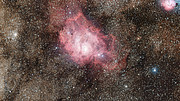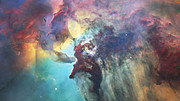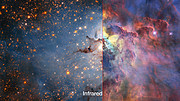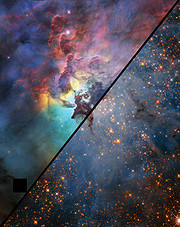The ALMA and APEX telescopes have peered
deep into space — back to the time when the Universe was one tenth of
its current age — and witnessed the beginnings of gargantuan cosmic
pileups: the impending collisions of young, starburst galaxies.
Astronomers thought that these events occurred around three billion
years after the Big Bang, so they were surprised when the new
observations revealed them happening when the Universe was only half
that age! These ancient systems of galaxies are thought to be building
the most massive structures in the known Universe: galaxy clusters.
Peering 90% of the way across the observable Universe, the
Miller team observed a galaxy protocluster named SPT2349-56. The light
from this object began travelling to us when the Universe was about a
tenth of its current age.
The new high-resolution ALMA observations finally revealed
that the two faint glows are not single objects, but are actually
composed of fourteen and ten individual massive galaxies respectively,
each within a radius comparable to the distance between the Milky Way
and the neighbouring Magellanic Clouds.
Current theoretical and computer models suggest that
protoclusters as massive as these should have taken much longer to
evolve. By using data from ALMA, with its superior resolution and
sensitivity, as input to sophisticated computer simulations, the
researchers are able to study cluster formation less than 1.5 billion
years after the Big Bang.
More Information
This research was presented in two papers, “The Formation
of a Massive Galaxy Cluster Core at z = 4.3”, by T. Miller et al., to
appear in the journal Nature, and “An Extreme Proto-cluster of Luminous Dusty Starbursts in the Early Universe”, by I. Oteo et al., which appeared in the Astrophysical Journal.
The Miller team is composed of: T. B. Miller (Dalhousie
University, Halifax, Canada; Yale University, New Haven, Connecticut,
USA), S. C. Chapman (Dalhousie University, Halifax, Canada; Institute of
Astronomy, Cambridge, UK), M. Aravena (Universidad Diego Portales,
Santiago, Chile), M. L. N. Ashby (Harvard-Smithsonian Center for
Astrophysics, Cambridge, Massachusetts, USA), C. C. Hayward
(Harvard-Smithsonian Center for Astrophysics, Cambridge, Massachusetts,
USA; Center for Computational Astrophysics, Flatiron Institute, New
York, New York, USA), J. D. Vieira (University of Illinois, Urbana,
Illinois, USA), A. Weiß (Max-Planck-Institut für Radioastronomie, Bonn,
Germany), A. Babul (University of Victoria, Victoria, Canada) , M.
Béthermin (Aix-Marseille Université, CNRS, LAM, Laboratoire
d’Astrophysique de Marseille, Marseille, France), C. M. Bradford
(California Institute of Technology, Pasadena, California, USA; Jet
Propulsion Laboratory, Pasadena, California, USA), M. Brodwin
(University of Missouri, Kansas City, Missouri, USA), J. E. Carlstrom
(University of Chicago, Chicago, Illinois USA), Chian-Chou Chen (ESO,
Garching, Germany), D. J. M. Cunningham (Dalhousie University, Halifax,
Canada; Saint Mary’s University, Halifax, Nova Scotia, Canada), C. De
Breuck (ESO, Garching, Germany), A. H. Gonzalez (University of Florida,
Gainesville, Florida, USA), T. R. Greve (University College London,
Gower Street, London, UK), Y. Hezaveh (Stanford University, Stanford,
California, USA), K. Lacaille (Dalhousie University, Halifax, Canada;
McMaster University, Hamilton, Canada), K. C. Litke (Steward
Observatory, University of Arizona, Tucson, Arizona, USA), J. Ma
(University of Florida, Gainesville, Florida, USA), M. Malkan
(University of California, Los Angeles, California, USA) , D. P. Marrone
(Steward Observatory, University of Arizona, Tucson, Arizona, USA), W.
Morningstar (Stanford University, Stanford, California, USA), E. J.
Murphy (National Radio Astronomy Observatory, Charlottesville, Virginia,
USA), D. Narayanan (University of Florida, Gainesville, Florida, USA),
E. Pass (Dalhousie University, Halifax, Canada), University of Waterloo,
Waterloo, Canada), R. Perry (Dalhousie University, Halifax, Canada), K.
A. Phadke (University of Illinois, Urbana, Illinois, USA), K. M.
Rotermund (Dalhousie University, Halifax, Canada), J. Simpson
(University of Edinburgh, Royal Observatory, Blackford Hill, Edinburgh;
Durham University, Durham, UK), J. S. Spilker (Steward Observatory,
University of Arizona, Tucson, Arizona, USA), J. Sreevani (University of
Illinois, Urbana, Illinois, USA), A. A. Stark (Harvard-Smithsonian
Center for Astrophysics, Cambridge, Massachusetts, USA), M. L. Strandet
(Max-Planck-Institut für Radioastronomie, Bonn, Germany) and A. L. Strom
(Observatories of The Carnegie Institution for Science, Pasadena,
California, USA).
The Oteo team is composed of: I. Oteo (Institute for
Astronomy, University of Edinburgh, Royal Observatory, Edinburgh, UK;
ESO, Garching, Germany), R. J. Ivison (ESO, Garching, Germany; Institute
for Astronomy, University of Edinburgh, Royal Observatory, Edinburgh,
UK), L. Dunne (Institute for Astronomy, University of Edinburgh, Royal
Observatory, Edinburgh, UK; Cardiff University, Cardiff, UK), A.
Manilla-Robles (ESO, Garching, Germany; University of Canterbury,
Christchurch, New Zealand), S. Maddox (Institute for Astronomy,
University of Edinburgh, Royal Observatory, Edinburgh, UK; Cardiff
University, Cardiff, UK), A. J. R. Lewis (Institute for Astronomy,
University of Edinburgh, Royal Observatory, Edinburgh, UK), G. de Zotti
(INAF-Osservatorio Astronomico di Padova, Padova, Italy), M. Bremer
(University of Bristol, Tyndall Avenue, Bristol, UK), D. L. Clements
(Imperial College, London, UK), A. Cooray (University of California,
Irvine, California, USA), H. Dannerbauer (Instituto de Astrofíısica de
Canarias, La Laguna, Tenerife, Spain; Universidad de La Laguna, Dpto.
Astrofísica, La Laguna, Tenerife, Spain), S. Eales (Cardiff University,
Cardiff, UK), J. Greenslade (Imperial College, London, UK), A. Omont
(CNRS, Institut d’Astrophysique de Paris, Paris, France; UPMC Univ.
Paris 06, Paris, France), I. Perez–Fournón (University of California,
Irvine, California, USA; Instituto de Astrofísica de Canarias, La
Laguna, Tenerife, Spain), D. Riechers (Cornell University, Space
Sciences Building, Ithaca, New York, USA), D. Scott (University of
British Columbia, Vancouver, Canada), P. van der Werf (Leiden
Observatory, Leiden University, Leiden, The Netherlands), A. Weiß
(Max-Planck-Institut für Radioastronomie, Bonn, Germany) and Z-Y. Zhang
(Institute for Astronomy, University of Edinburgh, Royal Observatory,
Edinburgh, UK; ESO, Garching, Germany).
ESO is the foremost intergovernmental astronomy
organisation in Europe and the world’s most productive ground-based
astronomical observatory by far. It has 15 Member States: Austria,
Belgium, the Czech Republic, Denmark, France, Finland, Germany, Italy,
the Netherlands, Poland, Portugal, Spain, Sweden, Switzerland and the
United Kingdom, along with the host state of Chile and with Australia as
a strategic partner. ESO carries out an ambitious programme focused on
the design, construction and operation of powerful ground-based
observing facilities enabling astronomers to make important scientific
discoveries. ESO also plays a leading role in promoting and organising
cooperation in astronomical research. ESO operates three unique
world-class observing sites in Chile: La Silla, Paranal and Chajnantor.
At Paranal, ESO operates the Very Large Telescope and its world-leading
Very Large Telescope Interferometer as well as two survey telescopes,
VISTA working in the infrared and the visible-light VLT Survey
Telescope. ESO is also a major partner in two facilities on Chajnantor,
APEX and ALMA, the largest astronomical project in existence. And on
Cerro Armazones, close to Paranal, ESO is building the 39-metre
Extremely Large Telescope, the ELT, which will become “the world’s
biggest eye on the sky”.
Links
Contact:
Axel Weiss
Max-Planck-Institut für Radioastronomie
Bonn, Germany
Tel: +49 228 525 273
Email: aweiss@mpifr-bonn.mpg.de
Carlos de Breuck
ESO
Garching, Germany
Tel: +49 89 3200 6613
Email: cdebreuc@eso.org
Richard Hook
ESO Public Information Officer
Garching bei München, Germany
Tel: +49 89 3200 6655
Cell: +49 151 1537 3591
Email: rhook@eso.org




























